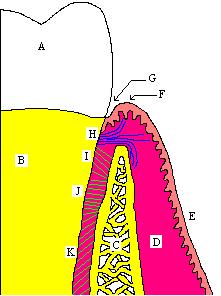Junctional epithelium
Editor-In-Chief: C. Michael Gibson, M.S., M.D. [1]
Overview

The junctional epithelium is that epithelium which lies at, and in health also defines, the base of the gingival sulcus. It attaches to the surface of the tooth with hemidesmosomes and is, on average, roughly 1 mm in width, constituting about one half of the biologic width.[1]
The junctional epithelium lies immediately apical to the sulcular epithelium, which lines the gingival sulcus from the base to the free gingival margin, where it interfaces with the epithelium of the oral cavity.
Cells in the junctional epithelium tend to have wide inter-cellular spaces, to allow the transmission of white blood cells from blood vessels to bottom of the gingival sulcus, to help prevent disease. Damage to the junctional epithelium results in it being irregular in texture, rather than smooth, and the formation of "pocket" epithelium, which is a primary symptom of gum disease.
References
- ↑ Carranza's Clinical Periodontology, 9th Ed. W.B. Saunders, 2002, page 23.
- Bosshardt, D.D., N.P. Lang, J Dent Res 84(1):9-20, 2005
- Oral Histology, Retrieved 2007-08-11.